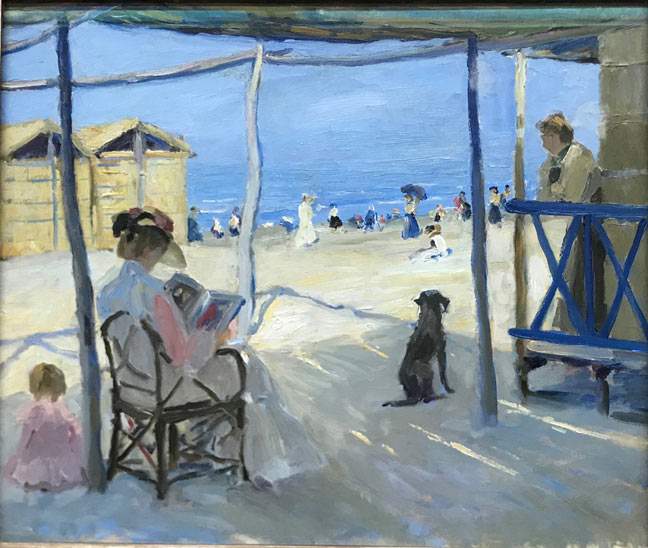From July 11 to October 25, 2020, the Regional Archaeological Museum in Aosta is hosting the exhibition GermanImpressionism. Liebermann, Slevogt, Corinth from the Landesmuseum Hannover: is an unprecedented exhibition project curated by Thomas Andratschke, head of the “New Masters” section of the Landesmuseum Hannover, and Daria Jorioz, art historian and manager of the Autonomous Region of Valle d’Aosta, and aims toaim to tell the story of the evolution ofGermanImpressionism through a significant selection of paintings, graphic works and sculptures, from the Landesmuseum Hannover, and for the most part never exhibited outside Germany. The exhibition aims to be an opportunity for the investigation, study and appreciation of important artists, little known to the Italian public but of great interest, taking into account the fact that German Impressionists often portrayed Italian nature and landscapes.
Starting from the relationship withFrench Impressionism, the exhibition develops in chronological order over three thematic areas: the first section accommodates the pioneers of German landscape painting up to 1890; the second features the masterpieces of the three most famous German Impressionists, namely Max Liebermann (Berlin, 1847 - 1935), Max Slevogt (Landshut, 1868 - Leinsweiler, 1932) and Lovis Corinth (Tapiau, 1858 - Zandvoort, 1925); and the third section presents their successors, the other exponents of the movement, active until 1930.
As is well known, Impressionism arose in France around 1870, and by the end of the century it had spread widely to other European countries, particularly Germany, Belgium, England, and significant influences on Italian art as well. With its lustrous colors and light, choppy brush strokes, FrenchImpressionism was intended to oppose formalism in nineteenth-century academic painting.In Germany, the origins of the Impressionist movement can be traced back to realistic landscape painting, the realistische Freilichtmalerei, which countered the dominant conservative taste within the German kingdom of Emperor Wilhelm of Prussia. As early as 1820, many artists left the enclosure of their ateliers to paint reality en plein air, in close contact with nature. The first section of the exhibition thus analyzes the realist tradition of landscape painting in Germany between 1828 and 1890, presenting works by pioneers who would pave the way for Impressionism, such as Carl Blechen (Cottbus, 1790 - Berlin, 1848), Franz Lenbach (Schrobenhausen, 1836 - Munich, 1904) and Hans Thoma (Bernau im Schwarzwald, 1839 - Karlsruhe, 1924).
From 1901 as part of the Berlin Secession, Liebermann, Slevogt, Corinth challenged the dominant academic current. In the capacity of “etching painters,” following the example of the French “Peintre-Graveurs,” they became the major representatives of Impressionism in Germany. This transition is presented in the exhibition in the second section through a selection of works by the three famous artists and other German landscape painters who adhered wholeheartedly to Impressionism until its final decline with the end of the Weimar Republic and the birth of the “New Objectivity”(Neue Sachlichkeit) art movement.
At the end of the 19th century, artists specializing in landscape painting from all over Europe moved to the countryside and out of urban centers. In settling in places deemed “picturesque,” they created veritable artists’ colonies, which until the outbreak of World War I were present throughout the area of Central Europe. Among the most famous are the French colony at Barbizon, Skagen in Denmark, and Worpswede in Lower Saxony. There is no shortage of painters who moved to Italy to paint the landscapes of our country. Among the founders of the German colony of Worpswede, the names of Otto Modersohn (Soest, 1865 - Rotenburg, 1943) and Hans am Ende (Trier, 1864 - Szczecin, 1918) appear. Alongside these painters, the third section of the exhibition presents the works of other significant artists, including the Bavarian Impressionist Max Feldbauer (Neumarkt in der Oberpfalz, 1869 - Oberschneiding, 1948), Henrich von Zügel (Murrhardt, 1850 - Munich, 1941), Philipp Klein (Mannheim, 1871 - Hornegg, 1907) and the sculptor August Gaul (Hanau, 1869 - Berlin, 1921).
The exhibition, accompanied by a richly illustrated bilingual Italian-French catalog with critical texts by Thomas Andratschke and Daria Jorioz published by Silvana Editoriale (on sale for 25 euros), is open daily from 9 a.m. to 7 p.m. Tickets: Full 6 euros, reduced 4 euros. Free admission for children under 18.Piemonte / Valle d’Aosta Museums Subscription Card. Subscription with the exhibition Memories of Earth at the Saint-Bénin Center in Aosta from August 7 to November 29, 2020: 10 euros full, 6 euros reduced.
Pictured: Philipp Klein, On the Beach at Viareggio (1906; oil on canvas; Hanover, Landesmuseum)
 |
| In Aosta, the exhibition on German Impressionism, with works from the Landesmuseum in Hanover |
Warning: the translation into English of the original Italian article was created using automatic tools. We undertake to review all articles, but we do not guarantee the total absence of inaccuracies in the translation due to the program. You can find the original by clicking on the ITA button. If you find any mistake,please contact us.